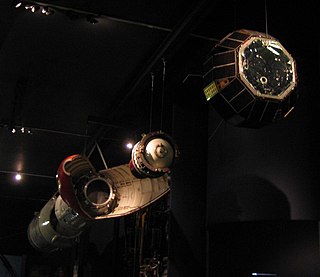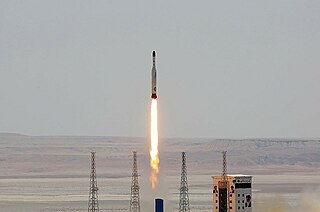| Mission type | Atmospheric |
|---|---|
| Operator | RAE |
| Mission duration | Failed to orbit |
| Start of mission | |
| Launch date | 2 September 1970, 00:34:05 UTC |
| Rocket | Black Arrow R2 |
| Launch site | Woomera LA-5B |
| Orbital parameters | |
| Reference system | Geocentric |
| Regime | Low Earth |
| Epoch | Planned |
Orba, also known as X-2, was intended to be the first satellite launched by a British rocket. It was launched at 00:34 GMT on 2 September 1970, atop a Black Arrow rocket from Launch Area 5B at Woomera, but failed to reach orbit after the second stage of the carrier rocket shut down 13 seconds early. [1] Orba was built from spare parts due to funding restrictions, [2] and was to have been used to measure upper atmosphere density by monitoring the decay of its orbit. [3]

Ariane 5 is a retired European heavy-lift space launch vehicle developed and operated by Arianespace for the European Space Agency (ESA). It was launched from the Centre Spatial Guyanais (CSG) in French Guiana. It was used to deliver payloads into geostationary transfer orbit (GTO), low Earth orbit (LEO) or further into space. The launch vehicle had a streak of 82 consecutive successful launches between 9 April 2003 and 12 December 2017. Since 2014, Ariane 6, a direct successor system, is in development.

Black Arrow, officially capitalised BLACK ARROW, was a British satellite expendable launch system.

The Prospero satellite, also known as the X-3, was launched by the United Kingdom in 1971. It was designed to undertake a series of experiments to study the effects of the space environment on communications satellites and remained operational until 1973, after which it was contacted annually for over 25 years. Although Prospero was the first British satellite to have been launched successfully by a British rocket, Black Arrow; the first British satellite placed in orbit was Ariel 1, launched in April 1962 on a US rocket.

The Pacific Spaceport Complex – Alaska (PSCA), formerly known as the Kodiak Launch Complex (KLC), is a dual-use commercial and military spaceport for sub-orbital and orbital launch vehicles. The facility is owned and operated by the Alaska Aerospace Corporation, a corporation owned by the Government of Alaska, and is located on Kodiak Island in Alaska.

This comparison of orbital launch systems lists the attributes of all individual rocket configurations designed to reach orbit. A first list contains rockets that are operational or in development as of 2023; a second list includes all upcoming rockets and a third list includes all retired rockets For the simple list of all conventional launcher families, see: Comparison of orbital launchers families. For the list of predominantly solid-fueled orbital launch systems, see: Comparison of solid-fueled orbital launch systems.

Waxwing was a British solid rocket motor used for apogee kick as the 3rd (upper) stage of the Black Arrow satellite launch vehicles. It was also known as Black Arrow-3. Waxwing was used to successfully place the Prospero X-3 satellite into low Earth orbit on 28 October 1971, Britain's only satellite launched on an indigenously developed launch vehicle. Before being separated from the Black Arrow launch vehicle, it would be spun on a turntable using six radial 'Imp' solid rocket motors to spin stabilise the satellite. This means that any discrepancy in thrust in any direction would be cancelled out. The Waxwing motor is now out of production.
Orbcomm is a family of low Earth orbit communications satellites, operated by the United States satellite communications company Orbcomm. As of July 2014, 51 such satellites have orbited Earth, with 50 still continuing to do so.
Miranda, also known as X-4, is a British satellite in low Earth orbit. The satellite was launched in March 1974 as an engineering test bed of technologies in orbit.

This article compares different orbital launcher families. The article is organized into two tables: the first contains a list of currently active and under-development launcher families, while the second contains a list of retired launcher families.

This article documents notable spaceflight events during the year 2019.

Notable spaceflight activities in 2017 included the maiden orbital flight of India's Geosynchronous Satellite Launch Vehicle Mark III on 5 June and the first suborbital test of Rocket Lab's Electron rocket, inaugurating the Mahia spaceport in New Zealand. The rocket is named for its innovative Rutherford engine which feeds propellants via battery-powered electric motors instead of the usual gas generator and turbopumps.

This article documents notable spaceflight events during the year 2018. For the first time since 1990, more than 100 orbital launches were performed globally.

Planet Labs PBC is a publicly held American Earth imaging company based in San Francisco, California. Their goal is to image the entirety of the Earth daily to monitor changes and pinpoint trends.

A small-lift launch vehicle is a rocket orbital launch vehicle that is capable of lifting 2,000 kg (4,400 lb) or less or under 5,000 kilograms (11,000 lb) of payload into low Earth orbit (LEO). The next larger category consists of medium-lift launch vehicles.
The JSAT constellation is a communication and broadcasting satellite constellation formerly operated by JSAT Corporation and currently by SKY Perfect JSAT Group. It has become the most important commercial constellation in Japan, and fifth in the world. It has practically amalgamated all private satellite operators in Japan, with only B-SAT left as a local competitor.

This article documents notable spaceflight events during the year 2020.

Semnan Space Center is the primary Iranian spaceport, located 50 km southeast of the city of Semnan in the north of the country.
{{cite web}}: CS1 maint: unfit URL (link)